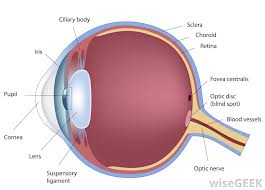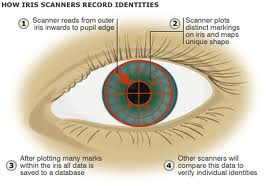An Introduction To Retinal Scanning and Iris Scan
Introduction To Retinal Scanning and
Iris Scan
Retinal scanning is the analysis of the
blood vessels at the back of the eye whereas Iris scanning takes a reading of
the characteristics of the iris.Scanning involves a low-intensity light and an coupler
to read different patterns.
Points of
reference used in an iris pattern as a basis for a match are 240 while
fingerprints uses about 60.
Known Facts
The left eye and right eye are not the same
on one person,and even identical twins (who shares the same DNA pattern) have different iris patterns.The iris
scanning has six
times more distinct identifiable features than fingerprints.The probability of
having two irises alike are one in ten to the 78th power (the
population of the earth is approx. ten to the tenth power). Glasses or contact
lenses do not interfere with the operation of iris recognition,and there is no
possible known way of copying a retina.
Retina
 |
| Eye Structure |
The human retina
is a thin tissue composed of neuralcells that is located in
the posterior portion of the eye. Because of the complex structure of
the capillaries that supply the retina with blood, each person’s
retina is unique. The network of blood vessels in the retina is complex, although
retinal patterns may be altered in cases
of diabetes, & other medical disorders, the
retina typically remains unchanged from birth until death.
Retinal
scanning also has any medical applications. Communicable illnesses such as AIDS,
syphilis, malaria, chicken pox well
as hereditary diseases like leukemia, lymphoma,
and sickle cell anemia impact the eyes. Pregnancy also
affects the eyes. Likewise, indications of chronic health conditions such
as congestive heart failure, atherosclerosis,
and cholesterol issues first appear in the eyes.
Iris
It is a circular
structure in the eye, responsible for controlling the diameter and size of
the pupils and amount of light reaching the retina. “Eye color”
is the color of the iris, which can be green, blue, or brown. Iris
recognition is an automated method of biometric identification
that uses mathematical pattern-recognition techniques on video images of
the irises of an eye.
 |
| IRIS Scan On Work |
How Does Retinal Scanning Works
Blood vessels on the retina are known to
absorb the infrared light faaster than the surrounding eye tissues so a low
intensity infrared light is used ,the light is reflected back to a video camera which takes 2 seconds to scan
the pattern.Then the pattern of blood vessels are converted to mathematical
patterns , which is then fed to computer(stored data).
Shortcomings
Iris scanners can be easily fooled by a high
quality image of an iris or face in place of the real thing.
It is usually difficult to adjust scanners
for different hieghts person’s if there irises pictures are to be captured in
succession.
Iris recognition is very difficult to
perform at a distance larger than a few meters and if the person to be
identified is not cooperating by holding the head still and looking into the camera.
Researchers have tricked iris scanners using
images generated from digital codes of stored irises. Criminals could exploit
this flaw to steal the identities of others.
Alcohol consumption causes recognition
degradation as the pupil dilates/constricts causing deformation in the iris
pattern.
Iris recognition in fiction
In Demolition
Man(1993), a character played by Wesley
Snipes uses the Warden's gouged eye to gain access through a security door.
In Dan
Brown’s 2000 novel Angels and Demons
an assassin gains access to a top secret CERN
laboratory using a scientist's eye using retina scan.
Steven
Spielberg's 2002 science fiction film Minority Report depicts a society in
which what appears to be a form of iris recognition has become daily practice.
An Article By Ajay Rai
VIT Universty
